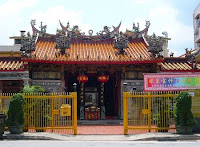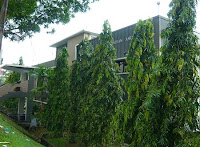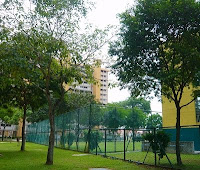Within the Farrer Park and Pek Kio area, there are many interesting names which reflect the diverse communities that once lived here. There is a "Little England" right in the heart of Pek Kio. Within the vicinity there are numerous streets named after English towns and counties - Oxford Road, Kent Road, Cambridge Road, Dorset Road, Carlisle Road, Gloucester Road, etc. In the past, many Eurasians lived in this "Little England".
.
I have lived at Cambridge Road for more than 10 years and then moved to Dorset Road during a resettlement. The Government torn down the old flats to make way for new roads and new flats. Though this has been something that happened more than 30 years ago, coming back here brings a lot of fond memories.
.
History of Farrer Park
Farrer Park has a rich, long history and is known for its many "firsts". It was the first race course and used a s runway for the first flight demonstration and the first aircraft landing in Singapore!
.
On 4th December 1919, Captain Ross Smith landed his Vickers Vimy at Farrer Park, on a pioneering fight from England to Australia. This marked the first aircraft to land in Singapore.
.
The race course was renamed Farrer Park in 1935 after R.J. Farrer, President of the Municipal Commissioners (1919 - 1931), and has been in use as a sports field since. The fields at Farrer Park were used by many of our past prominent National footballers like Dollah Kassim, Mohammed Noh and Samad Alapitchay.
.
The Farrer Park stadium, built in the early 1950s, was a favourite haunt of our national athletes in the 1950s to the early 1970s.
.
Map of Heritage Sites

.


^1. KK Women's & Children's Hospital. Formerly known as Kandang Kerbau Hospital, KK Women’s and Children’s Hospital is now the largest hospital specialising in healthcare for women and children. From its humble beginnings as a small general hospital in 1858 to a 30-bed maternity hospital in 1924, KKH has grown into an 827-bed hospital providing obstetric and gynaecology neonatology, and paediatric services. Often affectionally referred to as "KK" amongst locals, it is the birthplace of a sizeable proportion of Singaporeans, delivering over half of total newborns in the country as early as 1938.
.
In 1966, the hospital entered the Guinness Book of Records for delivering the highest number of newborns within a single maternity facility for that year, and it continued to hold on to this record for a full decade, delivering 85% of the population year after year.
.
When the hospital moved to its present site, the old premises was marked as a historical site by the NHB, a tribute to an institution which has been the birthplace of over 1.2 million Singaporeans since its inception. (yeah! proud that I was born here!)
.

^2. Farrer Park Swimming Pool. This was the place where we spent most of our time when the weather was hot. It was taken over by Mr Ang Peng Siong who now runs a swim school there. Mr Ang Peng Siong's Father was the pool supervisor for many years when Farrer Park Pool was a public pool.
.

^3. Tekka Centre. The original market built in 1915 was located across the street between
.

^4. Residence of Tan Teng Niah. This house is one of the last surviving Chinese Villas in this area. Built in 1900, this 8-room villa was built for Tan Teng Niah’s wife. Mr Tan was a prominent Chinese businessman and owned a confectionery business and other smaller ones such as a few sweet-making factories along Serangoon Road and a rubber smokehouse in Kerbau Road. He was one of the non-Indian communities who prospered in Little India.
.


^5. Shree Lakshmi Narayan Temple. Built by the North Indian community in 1960, its roots extend back to the early 20th century, when Indian immigrants from the North States of Ultar Pradash, Bihar, Punjab, Bengal and Gujarat arrived in Singapore. They came as herdmen, dairymen and money lenders. Those from Uttar Pradesh and Bihar were also emplyed as security guards in houses, shop and factories. Most of these Indians settled on the banks of Rocher Canal, Serangoon Road and the vicinity.
.
Before 1960, the North Indians had no special place of worship and used to worship at the north Hindu Association at Cuff Road. In 1960s, several residential units were purchased by the North Indian community and converted into the Shree Lakshminarayan Temple. Shree Laksminarayan Temple was declared open on 24 April 1969. The Temple is sancturay of the spirital values and culture of Sanatan Darm and Vedic Hindu tradition. It is a place of faith, devotion, worship, love, peace and harmony.
.
Today, the Temple is not only the place of worship, but it has become an important focal point for the Hindu Community to mneet and interact and fosters positive social values.
.

^6. Sri Veerama Kaliamman Temple is dedicated to the Hindu Goddess Kali, the Goddess of Power and the wife of Lord Shiva. The name “Veeramakaliamman” means the Courageous Mother Kali.
It is believed that this was the first temple in Singapore to venerate Kali. It was built as early as 1855 by Tamil labourers who worked at the lime kilns that lined Kampong Kapor in the mid to late 19th century. Because of this association with the lime kiln, this temple was originally called Sunnambu Kambam Kovil or the temple at the Lime Village. They built a shrine for Veeramakaliamman and by the late 19th century, a wooden temple had replaced the shrine. Over the years, the temple was renovated to what it is today.
.
The Gopuram or the tower over the entrance is better viewed from across the road. The tower, mounted with statues of various Hindu deities, is built so that it can be seen from a distance and enable Hindus to say their prayers from a distance. As in Buddhism, the lotus is commonly used in Hindu temple decorations as it is closely associated with many Hindu deities. eg. Vishnu holds a lotus in one hand and Lakshmi is seated on a lotus.
.


^7. Masjid Abdul Gaffoor. This mosque was built on land leased by Shaik Abdul Gaffoor Bin Shaik Hyder in 1859 and financed through the lease of the shophouses he has built in the 1880s. It was completed in 1910 and decalred a national monument in 1979.
.

^8. Kampong Kapor Methodist Church. The church was designed by Swm & Maclaren in the style of the Romanesque period in Italy, with a distinctive Spanish/baroque Dutch gable facade. Complete in 1929, it replaced an earlier church, the First Straits Chinese (Baba) Church in Middle Road, when the congregation grew too large.
.

^9. Jalan Besar Stadium was built in 1932 and is considered as the birthplace of Singapore football. It was here that the Malaya Cup (1932-1966) and later, the Malaysia Cup (1967-1973), were held for 41 years before moving over to the National Stadium. This was also the site for international soccer games and many important events.
.

^10. Jalan Besar Swimming Complex.
.


^11. Sri Srinivasa Perumal Temple is one of the oldest temples in Singapore. Located in Lttle India on Serangoon Road, where its tall Gopuram (tower) shows the different incarnations of Lord Vishnu. This large complex, dedicated to Vishnu, dates from 1855, but the 20-metres-tall Gopuram is a relatively recent addition, built in 1966 at a cost of S$300,000. The temple's five-tier Gopuram was a donation from P Govindasamy, one of the earliest Indian migrants who made good. He ultimately set up a chain of popular general goods stores in Little India and was known for his philanthropic works, a legacy continued by his sons today.
.


^12. Sakya Muni Buddha Gaya Temple is one of the most prominent and widely visited Buddhist temples in Singapore, often referred to as the Temple of 1,000 Lights. It features a 15m high statue of a seated Buddha, which weighs nearly 300 tons, as well as many smaller Buddha iamges and murals depicting the life of Shalyamuni Buddha. The large central statue is surrounded by a stylized aura made of numerous light bulbs, often litted during evening hours, from which the temple derives its nickname. In a small room beneath the altar is an image of a reclining Buddha, Buddha towards the end of his life, under a Yellow Seraka Tree. The Sakya Muni Buddha Gaya Temple was founded in 1927 by a Thai monk called Vutthisaras.
.

^13. Leong San See Temple or “Dragon Mountain Gate Temple” is one of the oldest Buddhist temples in Singapore. It was established in 1913 by a monk, Reverend Chun Wu, who came to Singapore from Fujian, China. The original Leong San See Temple was located in An Ping District of the Fujian Province, China. He had brought along with him a statue of Bodhisattva Kuan Yin (Goddess of Mercy) and purchased a plot of land at Race Course Road where he built a simple Leong San Lodge, in memory of the native Temple in China. An altar was set up for Kuan Yin.
.


^14. Sri Vadapathira Kaliamman Temple was founded as a small shrine by Tamil Hindu residents of Potong Pasir who wanted the protection of Mother Goddess and to sustain their cultural heritage. It was developed under B. Govindasamy Chettiar, pioneer labour contractor to the port of Singapore, philanthropist and Indian community leader.
.
Before B. Govindasamy Chettiar's death, he requested his nephew and son-in-law the late S.L. Perumal to build a new main tower the "Rajakopuram" and other additions to the Vadapathirakaliamman Temple.S.L. Perumal agreed and kept his word. When Hindu devotees worship here they feel the sanctity of this house of worship. S.L. Perumal built the present Temple at his own expense.
.


^15. Singapore Indian Association was established in 1923 with the objective of promoting the social, physical, intellectual, cultural and the general welfare of its members. When it was formed, the Association projected itself as a pan-Indian, rather than narrowly ethnic, language, religion, caste or region-based organization. This marked it as significantly different from most other Indian organisations in Singapore.
.
The Association led by the Indian mercantile and professional elite, expanding its membership to include the emerging white collar middle classes as well. Initially, the leaders of the Association were seized with the political spirit of the time in both India and Singapore. Many were supporters of the Indian independence movement, and many were also concerned about the social welfare and political rights of the wider Indian community in Singapore and British Malaya, which the city-state was then a part of.
.

^16. Ceylon Sports Club came into being in 1928, reconstituted from the Lanka Union founded by some Ceylonese students in 1920. The clubhouse was dynamited during World War II but was rebuilt after the war. Over the years, several renovations have been carried out and new services have been introduced to reach out to members.
.
Exploring Nature at Farrer Park
This self-guided walking trail introduces you to the amazing nature that can still be found in the Farrer Park area. Although the area is highly urbanised, planted trees and ornamental shrubs have become homes to some adpatable wild life.
.
Exploring and getting in touch with nature bring us closer to understanding how our environment works. Every leaf, flower, insect habitat has an important role to play to ensure that our planet Earth remains a healthy place for all of us.
.
If you are lucky, you may spot different types of birds, reptiles, butterflies, amphibians and wildflowers.
.

.

^Farrer Park Gardens Signage

^Trumpet Tree















No comments:
Post a Comment